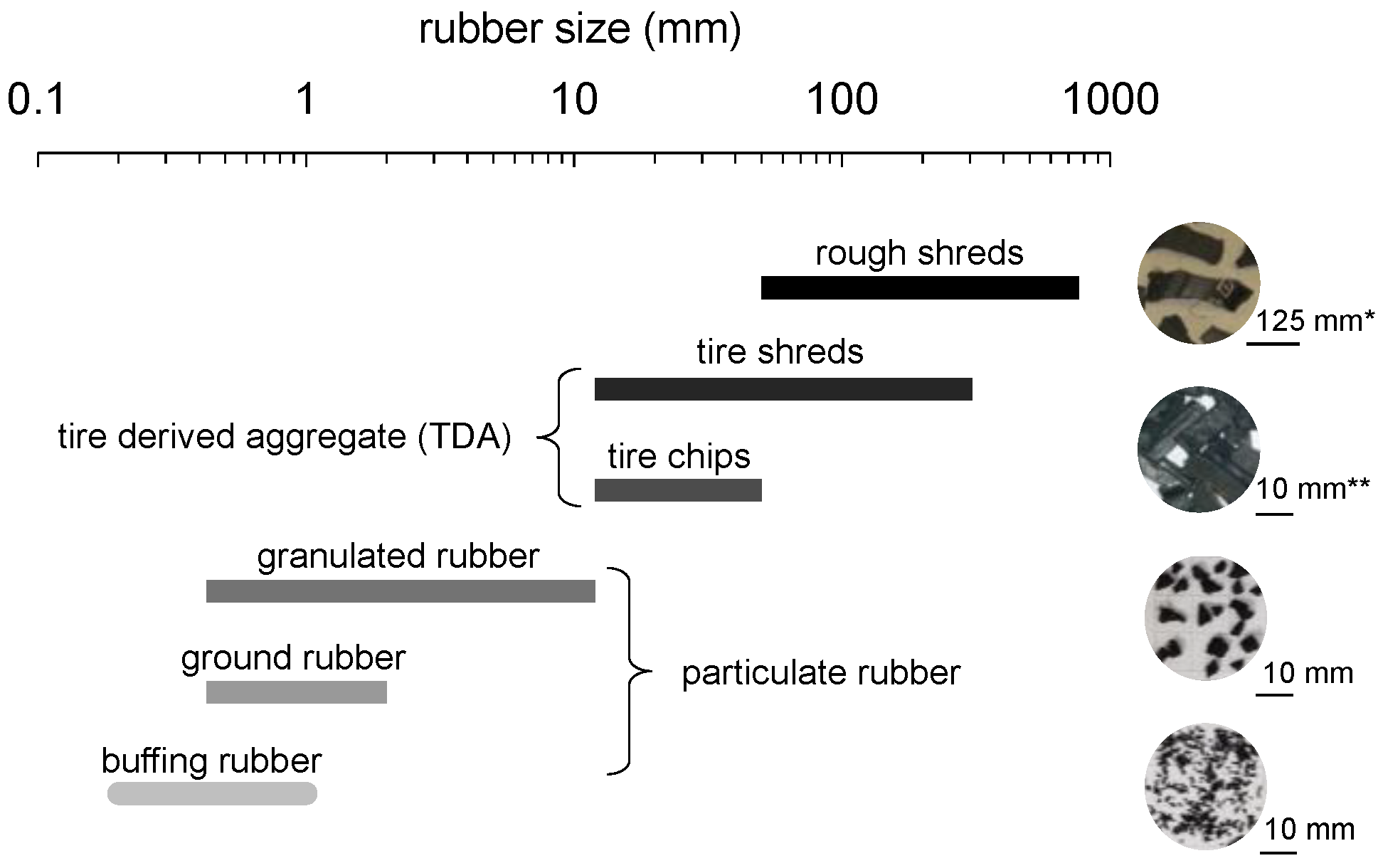Physical and Mechanical Properties of Granulated Rubber Mixed with Granular Soils—A Literature Review
Abstract
1. Introduction
| Country | ELTs Generation per Year | Recovery Rate (%) | Main Application | Reference | ||
|---|---|---|---|---|---|---|
| By Weight (Million Tons) | By Number (Million) | ELTs/Person 1 | ||||
| US | 4.2 | 250 | 0.77 | 84 | Tire-derived Fuel | [4] |
| Europe | 3.3 | 270 | 0.53 | 92 | Energy generation | [5] |
| Japan | 1.034 | 97 | 0.77 | 93 | Thermal recycling | [6] |
| UK | 0.436 | 40 | 0.62 | 98 | Energy generation | [5] |
| Australia | 0.41 | 20 | 0.80 | 38 | Export (Energy generation) | [7] |
| Canada | 0.42 | 28 | 0.74 | 98 | Tire crumbs and molded | [8] |
| New Zealand | 0.04 | 5 | 1.25 | 30 | Energy generation | [9] |
2. Geotechnical Properties of Soil-Rubber Mixtures (SRMs)
2.1. Packing States and Matrix Materials for SRMs
2.2. Maximum and Minimum Void Ratios of SMRs
2.3. Specific Gravity for SRMs
2.4. Compaction Properties of SRMs
2.4.1. Compactability of Pure Granulated Rubber
2.4.2. Compactability of Granular Soil-Rubber Mixtures
2.4.3. Dry Unit Weight of SRMs
2.5. Permeability of SRMs
2.5.1. Permeability of Granulated Rubber
2.5.2. Permeability of Sand-Rubber Mixtures
2.6. Compressibility Characteristics of SRMs
Volumetric Strain and Constrained Modulus of SRMs
2.7. Shear Strength Characteristics
2.7.1. Evaluation by Direct Shear Tests
2.7.2. Evaluation by Triaxial Tests
2.8. Dynamic Behaviour
2.9. Cyclic Response and Liquefaction Characteristics
3. Discussions
3.1. Gravel-Rubber Mixtures vs. Sand-Rubber Mixtures: What to Use and Why?
3.2. Environmental Aspects
4. Summary, Conclusions and Recommendations
- The geotechnical characteristics of SRMs depend not only on the rubber content (by mass or volume) in the mixtures but also on host soil type (i.e., sand or gravel), rubber particle size and shape, aspect ratio between rubber particles and soil grains (AR = D50R/D50S), as well as density state (packing) and applied stress level.
- Due to the smaller specific gravity values of rubber (Gs = 1.14–1.27) compared to granular soils (Gs = 2.5–2.7) the addition of rubber in the mixtures produces materials with lower dry density (or higher void ratios). Different from granulated soils, the maximum dry density of SRMs is better evaluated by Proctor impact compaction tests rather than the vibratory compaction technique. This is due to the elastic and damping properties of the rubber particles. In other words, vibratory compaction is mostly ineffective for compacting SMRs.
- For SRMs consisting of two different particle sizes (either D50R/D50S < 1 or D50R/D50S > 1) three packaging states can be defined during compaction depending on the percentage of smaller-sized material in the mixture: floating state, non-floating state and transitional state. This also greatly affects the mechanical response of SRMs.
- The inclusion of rubber particles in the SRMs drastically increases the compressibility of the compound materials. At any given vertical stress, a linear increase of 1-D volumetric strain can be observed with increasing VRC.
- The permeability of SRMs reported in previous investigations is almost constant up to VRC = 50% (similar to the permeability of sandy soil) and then increases with further increase in VRC. The permeability of pure rubber is usually similar to that of gravely soils.
- The majority of studies on sand-rubber mixtures indicated that there is a range of rubber content (VRC ≈ 20–50%) that enhance the shear strength of SRMs, and further rubber inclusion will result in a reduction in shear strength. In contrast, for gravel-rubber mixtures, a continuous reduction in shear strength (friction angle) can be observed by increasing rubber content.
- The main beneficial aspect of adding rubber particles in granular soil is the improvement of the dynamic properties and cyclic characteristics of the parent soil. Some investigations showed that even a small amount of rubber (for instance VRC < 10%) could increase Gmax especially for D50R/D50S < 1 as rubber fills the voids between soil particles. However, higher VRC values usually result in a reduction of Gmax (due to the soft nature of rubber), as well as an increase in the damping ratio (due to the energy absorption nature of the rubber).
- While strength and compressibility of SRMs have been characterized in many studies, further research on the dynamic and cyclic behavior of SMRs is still necessary (in particular gravel-rubber mixtures).
- The load-transmission concept between hard and soft grains is still poorly understood and studies focusing on the micro-scale mechanical behavior of SRMs (e.g., using DEM software) are encouraged.
- Previous studies on SRMs have mainly focused on sandy soils mixed with various rubber sizes. Yet, recent studies, have pointed out that to avoid inherent segregation of two-size sand-rubber mixtures, AR = 1 should be used, resulting in high costs from a practical viewpoint. Thus, gravel-rubber mixtures should be considered as a more suitable host soil to create more cost-effective SRMs. Yet, more studies are deemed necessary to facilitate the use of grave-rubber mixtures in many geotechnical applications.
- Finally, while SRMs are excellent construction materials from a geotechnical viewpoint, their ultimate adoption should be based also on environmental investigations to make sure that any harm to the environment is prevented.
Funding
Institutional Review Board Statement
Informed Consent Statement
Data Availability Statement
Acknowledgments
Conflicts of Interest
Abbreviations
| Cc | compression index |
| Cs | swelling index |
| CSR | cyclic stress ratio |
| D | damping ratio |
| D50R | median particle size of rubber |
| D50S | median particle size of soil |
| DEM | discrete element model |
| ELTs | end-of-life tires |
| void ratio of soil-rubber mixture | |
| void ratio of soil | |
| equivalent void ratio | |
| G | small-strain shear modulus |
| Gmax | maximum shear modulus |
| GRC | Gravimetric Rubber Content |
| Gs | specific gravity |
| k | permeability |
| M | constraint modulus |
| M100 | constraint modulus at vertical effective stress of 100 kPa |
| MDD | maximum dry density |
| OMC | optimum moisture content |
| q | deviatoric stress |
| qpeak | peak deviatoric stress |
| RC | rubber content |
| SRMs | soil-rubber mixtures |
| VRC | Volumetric Rubber Content |
| Vs | shear wave velocity |
| εv,1-D | one dimensional volumetric strain |
| φ | friction angle |
| γ | shear strain |
| dry unit weight of soil-rubber mixture | |
| dry unit weight of soil | |
| σn | normal stress |
| vertical effective stress | |
| vertical stress | |
| confining pressure | |
| σ′3 | effective confining pressure |
References
- Pehlken, A.; Essadiqi, E. Scrap Tire Recycling in Canada; CANMET Materials Technology Laboratory: Hamilton, ON, Canada, 2005. [Google Scholar]
- WBCSD. Managing End-of-Life Tires; WBCSD: Geneva, Switzerland, 2008. [Google Scholar]
- Torretta, V.; Rada, E.C.; Ragazzi, M.; Trulli, E.; Istrate, I.A.; Cioca, L.I. Treatment and disposal of tyres: Two EU approaches. A review. Waste Manag. 2015, 45, 152–160. [Google Scholar] [CrossRef]
- USTMA. 2017 U.S. Scrap Tire Management Summary; U.S. Tire Manufacturers Association: Washington, DC, USA, 2018. [Google Scholar]
- ETRMA. Annual Report 2017, Moving Innovation that Cares; ETRMA: Brussels, Belgium, 2017. [Google Scholar]
- JATMA. Tyre Industry of Japan; JATMA: Tokyo, Japan, 2018. [Google Scholar]
- Mountjoy, E.; Hasthanayake, D.; Freeman, T. Stocks and Fate of End-of-Life Tyres-2013–14 Study; National Environmental Protection Council: Washington, DC, USA, 2015.
- CATRA. Annual Report; CATRA: Rixheim, France, 2018. [Google Scholar]
- Ministry for the Environment. Environement New Zealand 2007; Ministry for the Environment: Wellington, New Zealand, 2015.
- Pincus, H.; Edil, T.; Bosscher, P. Engineering Properties of Tire Chips and Soil Mixtures. Geotech. Test. J. 1994, 17, 453. [Google Scholar] [CrossRef]
- Chaney, R.; Demars, K.; Masad, E.; Taha, R.; Ho, C.; Papagiannakis, T. Engineering Properties of Tire/Soil Mixtures as a Lightweight Fill Material. Geotech. Test. J. 1996, 19, 297–304. [Google Scholar] [CrossRef]
- Bosscher, P.J.; Edil, T.B.; Kuraoka, S. Design of Highway Embankments Using Tire Chips. J. Geotech. Geoenviron. Eng. 1997, 123, 295–304. [Google Scholar] [CrossRef]
- Tsang, H.-H. Seismic isolation by rubber–soil mixtures for developing countries. Earthq. Eng. Struct. Dyn. 2007, 37, 283–303. [Google Scholar] [CrossRef]
- Tsang, H.-H.; Lo, S.H.; Xu, X.; Sheikh, M.N. Seismic isolation for low-to-medium-rise buildings using granulated rubber-soil mixtures: Numerical study. Earthq. Eng. Struct. Dyn. 2012, 41, 2009–2024. [Google Scholar] [CrossRef]
- Hernández, E.; Palermo, A.; Granello, G.; Chiaro, G.; Banasiak, L.J. Eco-rubber Seismic-Isolation Foundation Systems: A Sustainable Solution for the New Zealand Context. Struct. Eng. Int. 2020, 30, 192–200. [Google Scholar] [CrossRef]
- Chiaro, G.; Palermo, A.; Granello, G.; Tasalloti, A.; Stratford, C.; Banasiak, L.J. Eco-rubber seismic-isolation foundation systems: A cost-effective way to build resilience. In Proceedings of the 2019 Pacific Conference on Earthquake Engineering, Auckland, New Zealand, 4–6 April 2019; pp. 1–8. [Google Scholar]
- Chiaro, G.; Tasalloti, A.; Palermo, A.; Granello, G.; Banasiak, L. Reuse of Waste Tires to Develop Eco-Rubber Seismic-Isolation Foundation Systems: Preliminary Results-Advances in Sustainable Construction and Resource Management; Hazarika, H., Madabhushi, G.S.P., Yasuhara, K., Bergado, D.T., Eds.; Springer: Singapore, 2021; pp. 159–169. [Google Scholar]
- Tsiavos, A.; Alexander, N.A.; Diambra, A.; Ibraim, E.; Vardanega, P.J.; Gonzalez-Buelga, A.; Sextos, A. A sand-rubber deformable granular layer as a low-cost seismic isolation strategy in developing countries: Experimental investigation. Soil Dyn. Earthq. Eng. 2019, 125, 105731. [Google Scholar] [CrossRef]
- Pitilakis, D.; Anastasiadis, A.; Vratsikidis, A.; Kapouniaris, A.; Massimino, M.; Abate, G.; Corsico, S. Large-Scale Field Testing of Geotechnical Seismic Isolation of Structures Using Gravel-Rubber Mixtures; Aristotle University of Thessaloniki: Thessaloniki, Greece, 2021. [Google Scholar]
- Hazarika, H.; Pasha, S.M.K.; Ishibashi, I.; Yoshimoto, N.; Kinoshita, T.; Endo, S.; Karmokar, A.K.; Hitosugi, T. Tire-chip reinforced foundation as liquefaction countermeasure for residential buildings. Soils Found. 2020, 60, 315–326. [Google Scholar] [CrossRef]
- Paramasivam, B.; Dashti, S.; Liel, A.B. In-Ground Gravel–Rubber Panel Walls to Mitigate and Base Isolate Shallow-Founded Structures on Liquefiable Ground. J. Geotech. Geoenviron. Eng. 2020, 146, 04020087. [Google Scholar] [CrossRef]
- Yujie, Q.; Buddhima, I. Energy-Based Approach to Assess the Performance of a Granular Matrix Consisting of Recycled Rubber, Steel-Furnace Slag, and Coal Wash. J. Mater. Civ. Eng. 2020, 32, 04020169. [Google Scholar] [CrossRef]
- Indraratna, B.; Qi, Y.; Ngo, T.N.; Rujikiatkamjorn, C.; Neville, T.; Ferreira, F.B.; Shahkolahi, A. Use of Geogrids and Recycled Rubber in Railroad Infrastructure for Enhanced Performance. Geosciences 2019, 9, 30. [Google Scholar] [CrossRef]
- ASTM. Standard Practice for Use of Scrap Tires in Civil Engineering Applications; American Society for Testing and Materials: West Conshohocken, PA, USA, 2017. [Google Scholar]
- Kim, H.-K.; Santamarina, J.C. Sand-rubber mixtures (large rubber chips). Can. Geotech. J. 2008, 45, 1457–1466. [Google Scholar] [CrossRef]
- Tasalloti, A.; Chiaro, G.; Palermo, A.; Banasiak, L. Effect of Rubber Crumbs Volumetric Content on the Shear Strength of Gravelly Soil in Direct Shear Apparatus. Geo-Congress 2020, 259–266. [Google Scholar] [CrossRef]
- Tasalloti, A.; Chiaro, G.; Banasiak, L.; Palermo, A. Experimental investigation of the mechanical behaviour of gravel-granulated tyre rubber mixtures. Constr. Build. Mater. 2021, 273, 121749. [Google Scholar] [CrossRef]
- Balunaini, U.; Mohan, V.K.D.; Prezzi, M.; Salgado, R. Shear strength of tyre chip-sand and tyre shred-sand mixtures. Proc. Inst. Civ. Eng. Geotech. Eng. 2014, 167, 585–595. [Google Scholar] [CrossRef]
- Mashiri, M.S.; Vinod, J.S.; Sheikh, M.N.; Carraro, J.A.H. Shear modulus of sand-tyre chip mixtures. Environ. Geotech. 2018, 5, 336–344. [Google Scholar] [CrossRef]
- Ghazavi, M.; Sakhi, M.A. Influence of Optimized Tire Shreds on Shear Strength Parameters of Sand. Int. J. Géoméch. 2005, 5, 58–65. [Google Scholar] [CrossRef]
- Lee, J.H.; Salgado, R.; Bernal, A.; Lovell, C.W. Shredded Tires and Rubber-Sand as Lightweight Backfill. J. Geotech. Geoenviron. Eng. 1999, 125, 132–141. [Google Scholar] [CrossRef]
- Kaneko, T.; Orense, R.P.; Hyodo, M.; Yoshimoto, N. Seismic Response Characteristics of Saturated Sand Deposits Mixed with Tire Chips. J. Geotech. Geoenviron. Eng. 2013, 139, 633–643. [Google Scholar] [CrossRef]
- Mashiri, M.; Vinod, J.; Sheikh, M.N.; Tsang, H.-H. Shear strength and dilatancy behaviour of sand-tyre chip mixtures. Soils Found. 2015, 55, 517–528. [Google Scholar] [CrossRef]
- Promputthangkoon, P.; Hyde, A.F.L. Compressibility and liquefaction potential of rubber composite soils. In Proceedings of the International Workshop on Scrap Tire Derived Geomaterials—Opportunities and Challenges, Yokosuka, Japan, 23–24 March 2007; pp. 161–170. [Google Scholar]
- Sheikh, M.N.; Mashiri, M.S.; Vinod, J.S.; Tsang, H.-H. Shear and Compressibility Behavior of Sand–Tire Crumb Mixtures. J. Mater. Civ. Eng. 2013, 25, 1366–1374. [Google Scholar] [CrossRef]
- Tatlisoz, N.; Edil, T.B.; Benson, C.H. Interaction between Reinforcing Geosynthetics and Soil-Tire Chip Mixtures. J. Geotech. Geoenviron. Eng. 1998, 124, 1109–1119. [Google Scholar] [CrossRef]
- Youwai, S.; Bergado, D.T. Strength and deformation characteristics of shredded rubber tire-sand mixtures. Can. Geotech. J. 2003, 40, 254–264. [Google Scholar] [CrossRef]
- Arulrajah, A.; Mohammadinia, A.; Maghool, F.; Horpibulsuk, S. Tyre derived aggregates and waste rock blends: Resilient moduli characteristics. Constr. Build. Mater. 2019, 201, 207–217. [Google Scholar] [CrossRef]
- Nakhaei, A.; Marandi, S.; Kermani, S.S.; Bagheripour, M. Dynamic properties of granular soils mixed with granulated rubber. Soil Dyn. Earthq. Eng. 2012, 43, 124–132. [Google Scholar] [CrossRef]
- Pasha, S.M.K.; Hazarika, H.; Yoshimoto, N. Physical and mechanical properties of Gravel-Tire Chips Mixture (GTCM). Geosynth. Int. 2019, 26, 92–110. [Google Scholar] [CrossRef]
- Chiaro, G.; Tasalloti, A.; Banasiak, L.; Palermo, A.; Granello, G.; Rees, S. Sustainable recycling of end-of-life tyres in civil (geotechnical) engineering applications: Turning issues into opportunities in the New Zealand context. NZ Geomech. News 2020, 99, 38–47. [Google Scholar]
- Ahmed, I.; Lovell, C.W. Rubber soils as lightweight geomaterials. Transp. Res. Rec. 1993, 1422, 61–70. [Google Scholar]
- Anastasiadis, A.; Senetakis, K.; Pitilakis, K. Small-Strain Shear Modulus and Damping Ratio of Sand-Rubber and Gravel-Rubber Mixtures. Geotech. Geol. Eng. 2012, 30, 363–382. [Google Scholar] [CrossRef]
- Edinçliler, A.; Ayhan, V. Influence of tire fiber inclusions on shear strength of sand. Geosynth. Int. 2010, 17, 183–192. [Google Scholar] [CrossRef]
- Edinçliler, A.; Cagatay, A. Weak subgrade improvement with rubber fibre inclusions. Geosynth. Int. 2013, 20, 39–46. [Google Scholar] [CrossRef]
- Fu, R.; Coop, M.R.; Li, X.Q. Influence of Particle Type on the Mechanics of Sand-Rubber Mixtures. J. Geotech. Geoenviron. Eng. 2017, 143, 4017059. [Google Scholar] [CrossRef]
- Ghazavi, M. Shear strength characteristics of sand-mixed with granular rubber. Geotech. Geol. Eng. 2004, 22, 401–416. [Google Scholar] [CrossRef]
- Zhou, W.; Xu, K.; Ma, G.; Yang, L.; Chang, X. Effects of particle size ratio on the macro- and microscopic behaviors of binary mixtures at the maximum packing efficiency state. Granul. Matter 2016, 18, 81. [Google Scholar] [CrossRef]
- Chang, C.S.; Meidani, M. Dominant grains network and behavior of sand-silt mixtures: Stress-strain modeling. Int. J. Numer. Anal. Methods Géoméch. 2012, 37, 2563–2589. [Google Scholar] [CrossRef]
- Lee, J.-S.; Dodds, J.; Santamarina, J.C. Behavior of Rigid-Soft Particle Mixtures. J. Mater. Civ. Eng. 2007, 19, 179–184. [Google Scholar] [CrossRef]
- Salvatore, I.; Giuseppe, M.; Gabriele, C.; Erminio, S. Predictive correlations for the compaction of clean sands. Transp. Geotech. 2015, 4, 38–49. [Google Scholar] [CrossRef]
- Mashiri, M.S.; Vinod, J.S.; Sheikh, M.N. Liquefaction Potential and Dynamic Properties of Sand-Tyre Chip (STCh) Mixtures. Geotech. Test. J. 2016, 39, 69–79. [Google Scholar] [CrossRef]
- Li, B.; Huang, M.; Zeng, X. Dynamic Behavior and Liquefaction Analysis of Recycled-Rubber Sand Mixtures. J. Mater. Civ. Eng. 2016, 28, 4016122. [Google Scholar] [CrossRef]
- Chiaro, G.; Palermo, A.; Granello, G.; Banasiak, L. Direct shear behaviour of gravel-granulated tyre rubber mixtures. In Proceedings of the 13th Australia New Zealand Conference on Geomechanics, Perth, Australia, 1–3 April 2019. [Google Scholar]
- Humphrey, D.N.; Sandford, T.C. Tire chips as lightweight subgrade fill and retaining wall backfill. In Proceedings of the Symposium on Recovery and Effective Reuse of Discarded Materials and By-Products for Construction of Highway Facilities, Denver, CO, USA, 19–22 October 1993; pp. 5–87. [Google Scholar]
- Lee, C.; Truong, Q.H.; Lee, W.; Lee, J.-S. Characteristics of Rubber-Sand Particle Mixtures according to Size Ratio. J. Mater. Civ. Eng. 2010, 22, 323–331. [Google Scholar] [CrossRef]
- Moo-Young, H.; Sellasie, K.; Zeroka, D.; Sabnis, G. Physical and Chemical Properties of Recycled Tire Shreds for Use in Construction. J. Environ. Eng. 2003, 129, 921–929. [Google Scholar] [CrossRef]
- Abdelrazek, A.; El-Sherbiny, R.M.; Lotfi, H.A. Mechanical properties and time-dependent behaviour of sand-granulated rubber mixtures. Géoméch. Geoengin. 2018, 13, 288–300. [Google Scholar] [CrossRef]
- Anastasiadis, A.; Senetakis, K.; Pitilakis, K.; Gargala, C.; Karakasi, I.; Edil, T.; Dean, S.W. Dynamic Behavior of Sand/Rubber Mixtures. Part I: Effect of Rubber Content and Duration of Confinement on Small-Strain Shear Modulus and Damping Ratio. In Testing and Specification of Recycled Materials for Sustainable Geotechnical Construction; ASTM International: West Conshohocken, PA, USA, 2012. [Google Scholar]
- Edinçliler, A.; Baykal, G.; Saygılı, A. Influence of different processing techniques on the mechanical properties of used tires in embankment construction. Waste Manag. 2010, 30, 1073–1080. [Google Scholar] [CrossRef]
- Suits, L.D.; Sheahan, T.; Yang, S.; Lohnes, R.; Kjartanson, B. Mechanical Properties of Shredded Tires. Geotech. Test. J. 2002, 25, 44. [Google Scholar] [CrossRef]
- Rao, G.V.; Dutta, R.K. Compressibility and Strength Behaviour of Sand-tyre Chip Mixtures. Geotech. Geol. Eng. 2006, 24, 711–724. [Google Scholar] [CrossRef]
- Valdes, J.R.; Evans, T.M. Sand-rubber mixtures: Experiments and numerical simulations. Can. Geotech. J. 2008, 45, 588–595. [Google Scholar] [CrossRef]
- Lee, C.; Shin, H.; Lee, J.-S. Behavior of sand-rubber particle mixtures: Experimental observations and numerical simulations. Int. J. Numer. Anal. Methods Géoméch. 2014, 38, 1651–1663. [Google Scholar] [CrossRef]
- Ngo, A.T.; Valdes, J.R. Creep of Sand-Rubber Mixtures. J. Mater. Civ. Eng. 2007, 19, 1101–1105. [Google Scholar] [CrossRef]
- Foose, G.J.; Benson, C.H.; Bosscher, P.J. Sand Reinforced with Shredded Waste Tires. J. Geotech. Eng. 1996, 122, 760–767. [Google Scholar] [CrossRef]
- Attom, M.F. The use of shredded waste tires to improve the geotechnical engineering properties of sands. Environ. Earth Sci. 2005, 49, 497–503. [Google Scholar] [CrossRef]
- Bergado, D.T.; Youwai, S.; Rittirong, A. Strength and deformation characteristics of flat and cubical rubber tyre chip-sand mixtures. Géotechnique 2005, 55, 603–606. [Google Scholar] [CrossRef]
- Edinçliler, A.; Baykal, G.; Dengili, K. Determination of static and dynamic behavior of recycled materials for highways. Resour. Conserv. Recycl. 2004, 42, 223–237. [Google Scholar] [CrossRef]
- Gotteland, P.; Lambert, S.; Balachowski, L. Strength characteristics of tyre chips-sand mixtures. Stud. Geotech. Mech. 2005, 27, 55–66. [Google Scholar]
- Zornberg, J.G.; Christopher, B.R.; Larocque, C.J. Applications of Tire Bales in Transportation Projects. Recycl. Mater. Geotech. 2004, 42–60. [Google Scholar] [CrossRef]
- Suits, L.D.; Sheahan, T.; Ghazavi, M.; Sakhi, M. Optimization of Aspect Ratio of Waste Tire Shreds in Sand-Shred Mixtures Using CBR Tests. Geotech. Test. J. 2005, 28, 564–569. [Google Scholar] [CrossRef]
- Wu, W.Y.; Benda, C.C.; Cauley, R.F. Triaxial Determination of Shear Strength of Tire Chips. J. Geotech. Geoenviron. Eng. 1997, 123, 479–482. [Google Scholar] [CrossRef]
- Rowe, P.W. The stress-dilatancy relation for static equilibrium of an assembly of particles in contact. Proc. R. Soc. Lond. Ser. A Math. Phys. Sci. 1962, 269, 500–527. [Google Scholar] [CrossRef]
- Taylor, D.W. Fundamentals of Soil Mechanics; John Wiley & Sons: New York, NY, USA, 1948. [Google Scholar]
- Zornberg, J.G.; Cabral, A.R.; Viratjandr, C. Behaviour of tire shred-sand mixtures. Can. Geotech. J. 2004, 41, 227–241. [Google Scholar] [CrossRef]
- Fu, R.; Coop, M.R.; Li, X.Q. The mechanics of a compressive sand mixed with tyre rubber. Géotech. Lett. 2014, 4, 238–243. [Google Scholar] [CrossRef]
- Senetakis, K.; Anastasiadis, A.; Pitilakis, K. Dynamic properties of dry sand/rubber (SRM) and gravel/rubber (GRM) mixtures in a wide range of shearing strain amplitudes. Soil Dyn. Earthq. Eng. 2012, 33, 38–53. [Google Scholar] [CrossRef]
- Senetakis, K.; Anastasiadis, A. Effects of state of test sample, specimen geometry and sample preparation on dynamic properties of rubber-sand mixtures. Geosynth. Int. 2015, 22, 301–310. [Google Scholar] [CrossRef]
- Senetakis, K.; Anastasiadis, A.; Pitilakis, K.; Souli, A. Dynamic behavior of sand/rubber mixtures, part II: Effect of rubber content on G/G o-γ-DT curves and volumetric threshold strain. In Testing and Specification of Recycled Materials for Sustainable Geotechnical Construction; ASTM International: West Conshohocken, PA, USA, 2012. [Google Scholar]
- Chaney, R.; Demars, K.; Feng, Z.-Y.; Sutter, K. Dynamic Properties of Granulated Rubber/Sand Mixtures. Geotech. Test. J. 2000, 23, 338. [Google Scholar] [CrossRef]
- Hazarika, H.; Abdullah, A. Improvement effects of two and three dimensional geosynthetics used in liquefaction countermeasures. Jpn. Geotech. Soc. Spéc. Publ. 2016, 2, 2336–2341. [Google Scholar] [CrossRef]
- Banasiak, L.; Chiaro, G.; Palermo, A.; Granello, G. Environmental Implications of the Recycling of End-of-Life Tires in Seismic Isolation Foundation Systems BT-Advances in Sustainable Construction and Resource Management; Hazarika, H., Madabhushi, G.S.P., Yasuhara, K., Bergado, D.T., Eds.; Springer: Singapore, 2021; pp. 43–52. [Google Scholar]
- UNEP. Basel Convention Working Group Technical Guidelines on the Identification and Management of Used Tyres; Basel Convention on the Control of Transboundary Movements of Hazardous Wastes and Their Disposal, Document No. 10; UNEP: Nairobi, Kenya, 1999. [Google Scholar]
- Ministry for the Environment. Waste Tyres Economic Research; Report 3; Ministry for the Environment: Wellington, New Zealand, 2015.
- MWH. End-of-Life Tyre Management: Storage Options; Final Report for the Ministry for the Environment; MWH: London, UK, 2004.
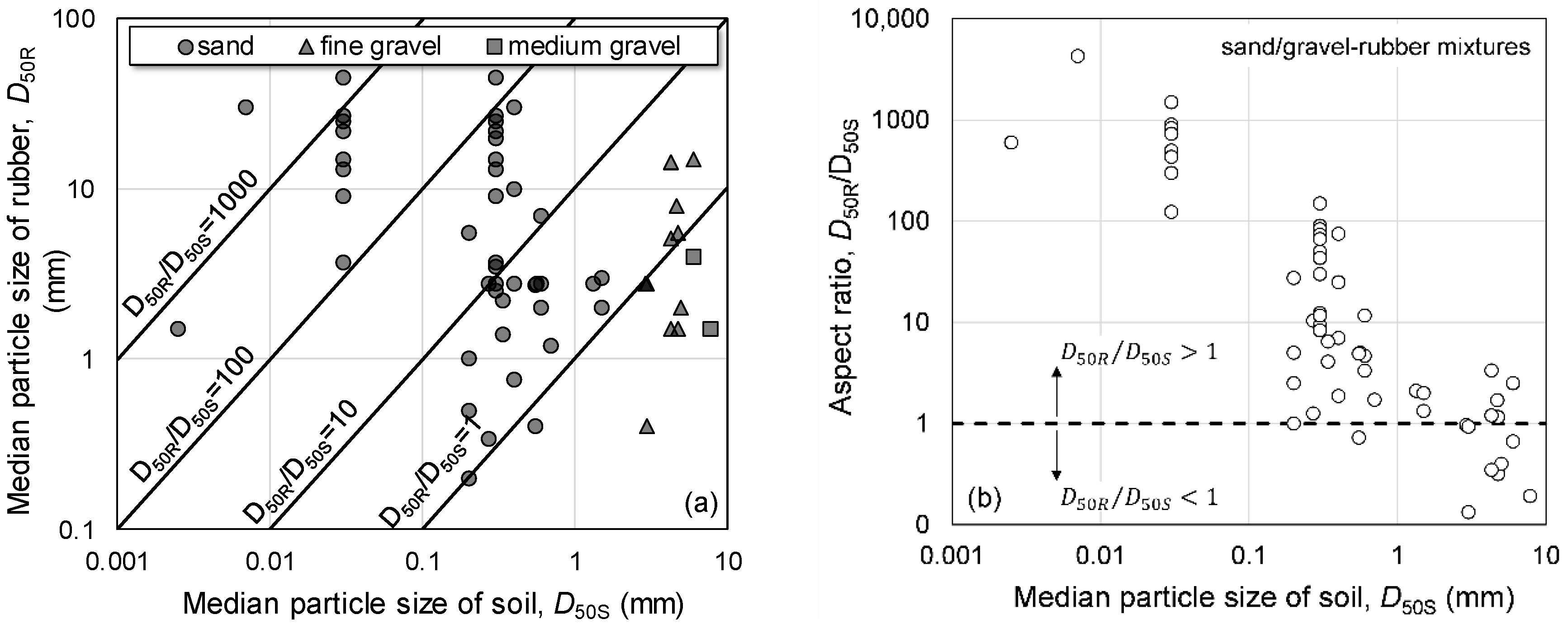
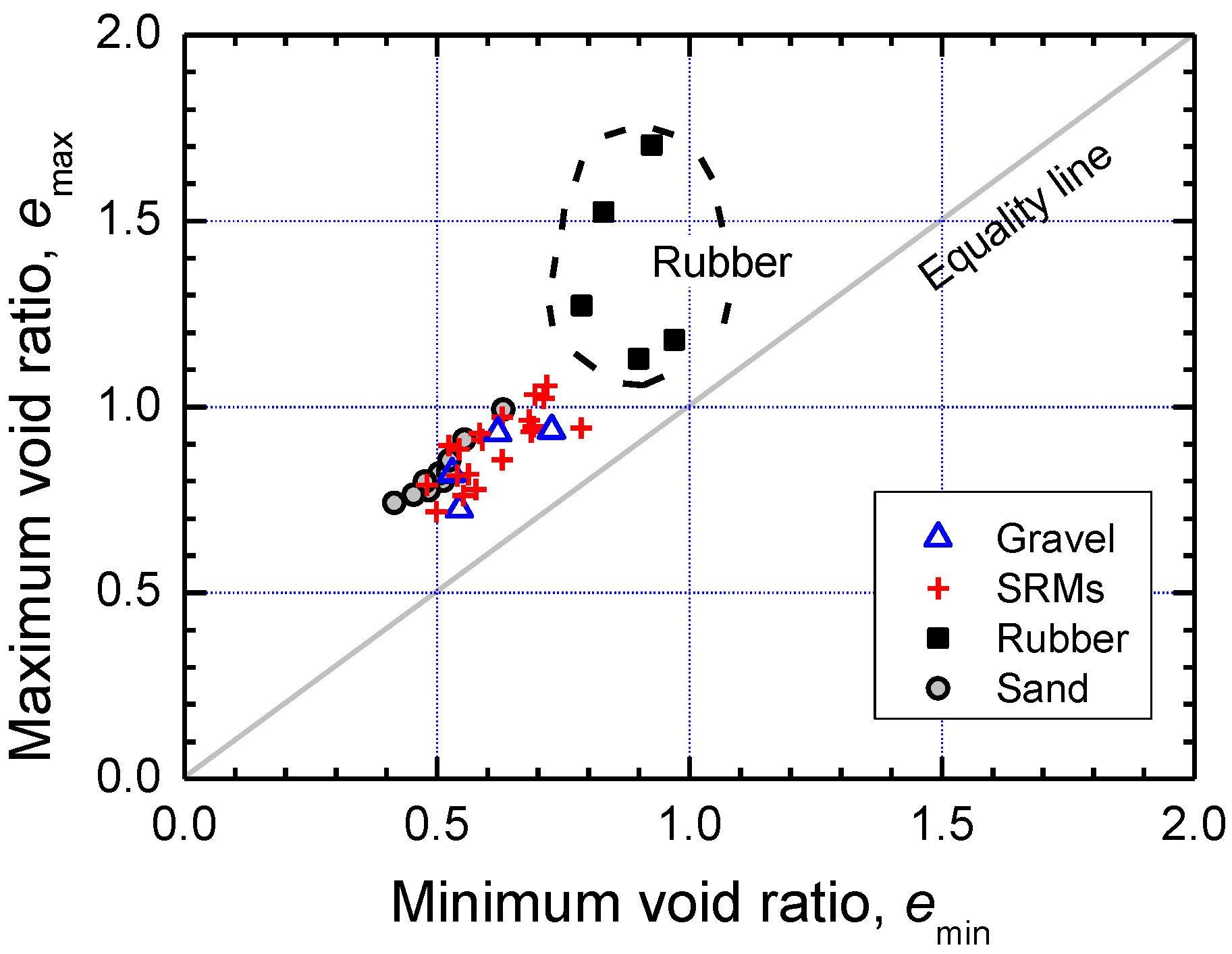

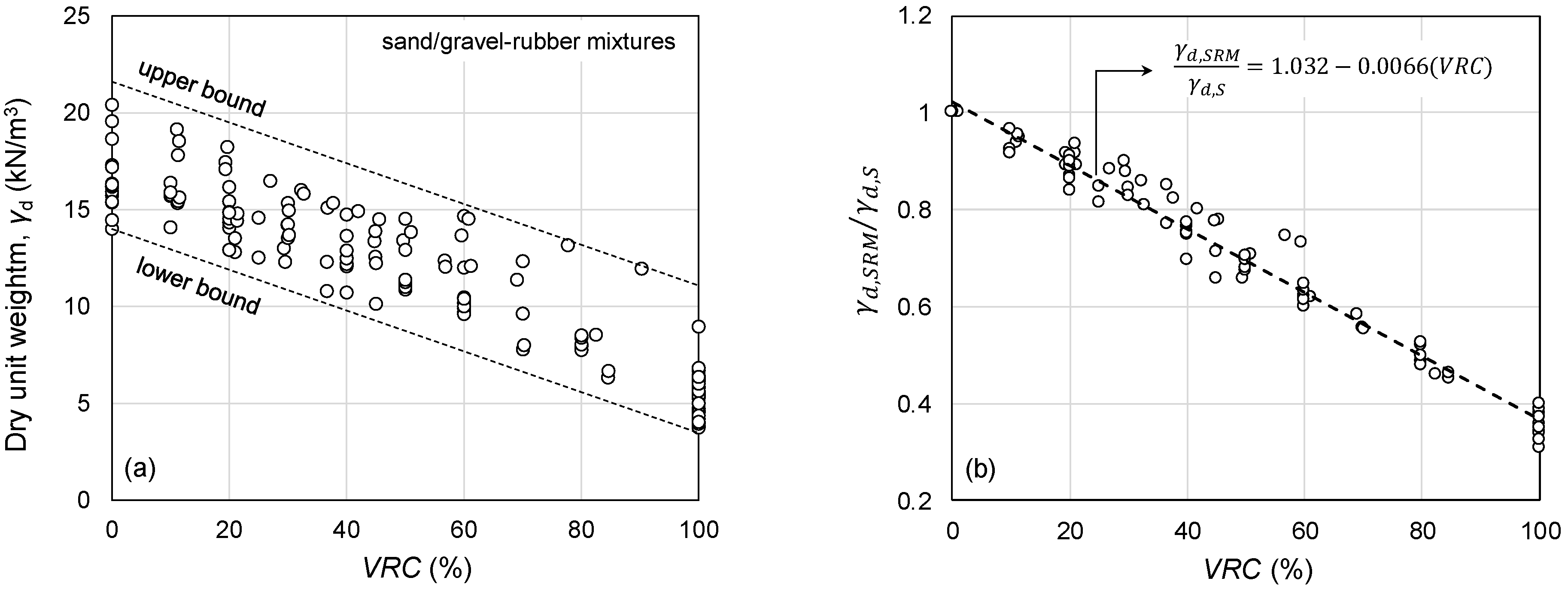

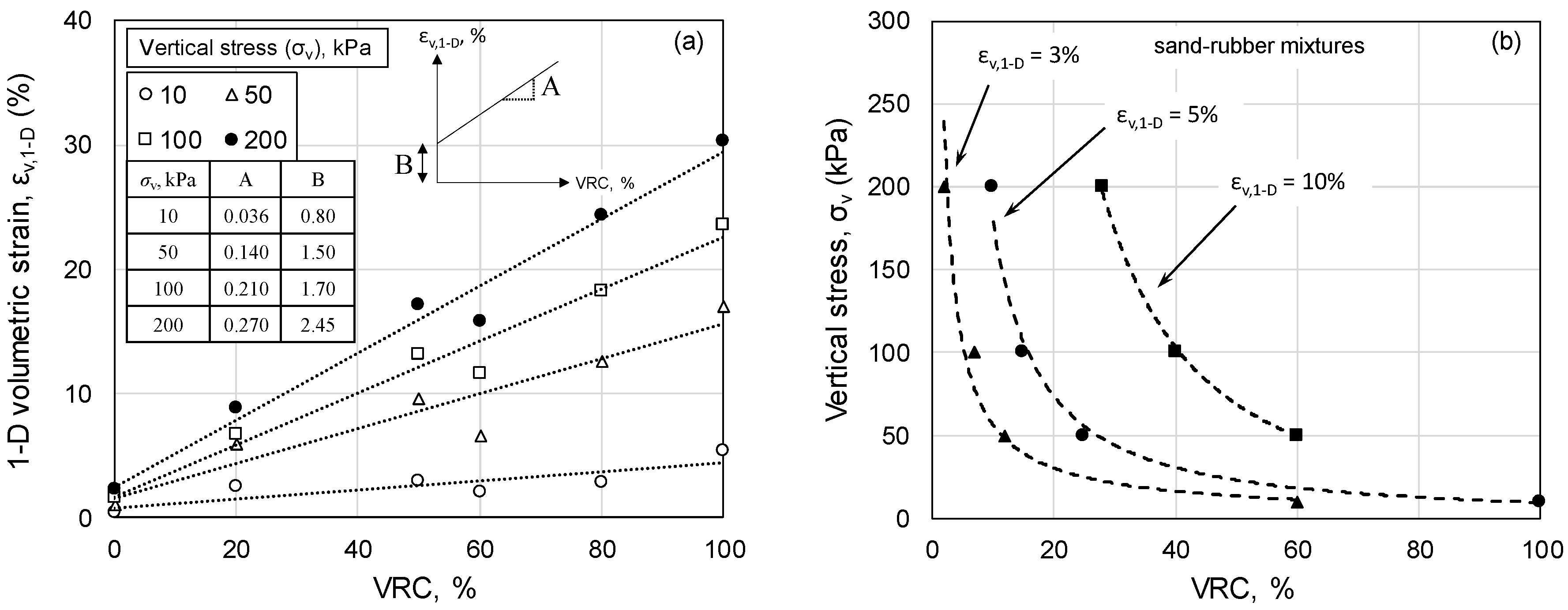

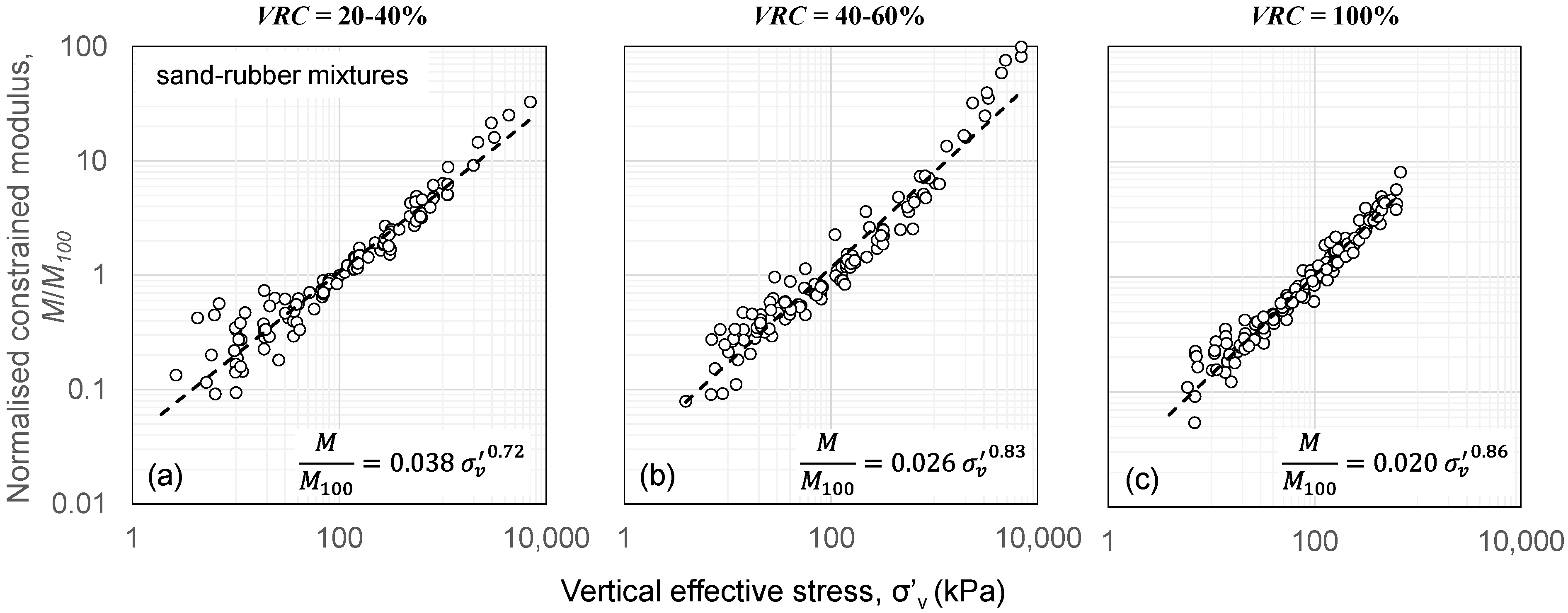
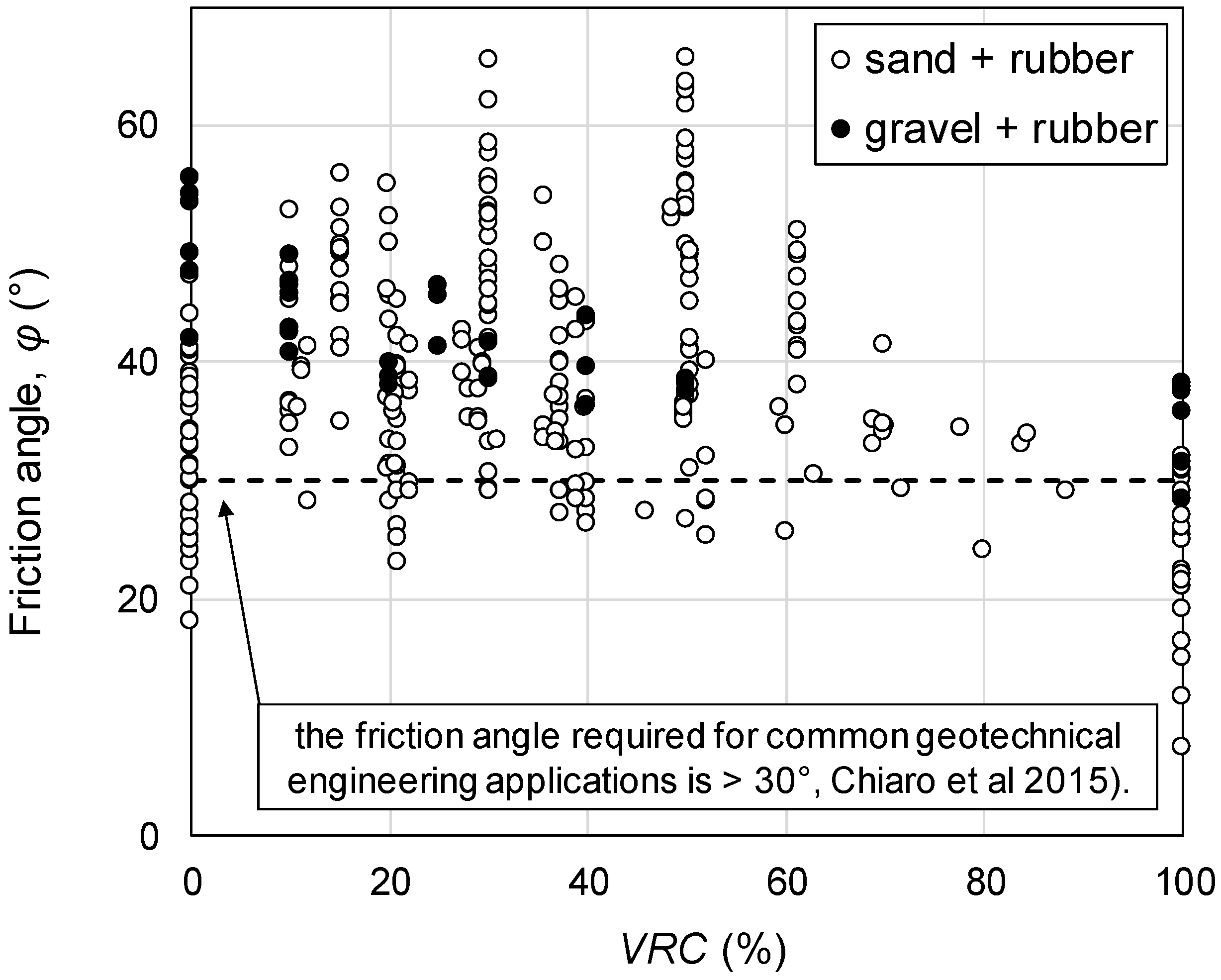
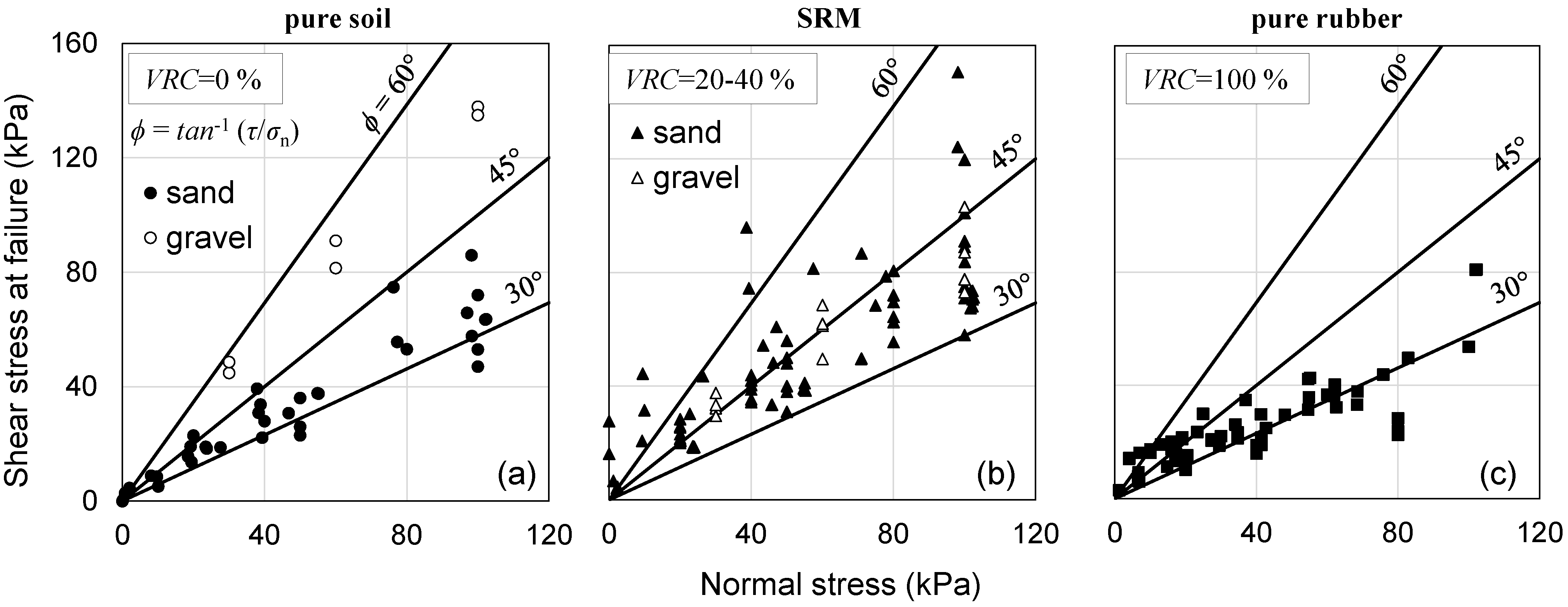
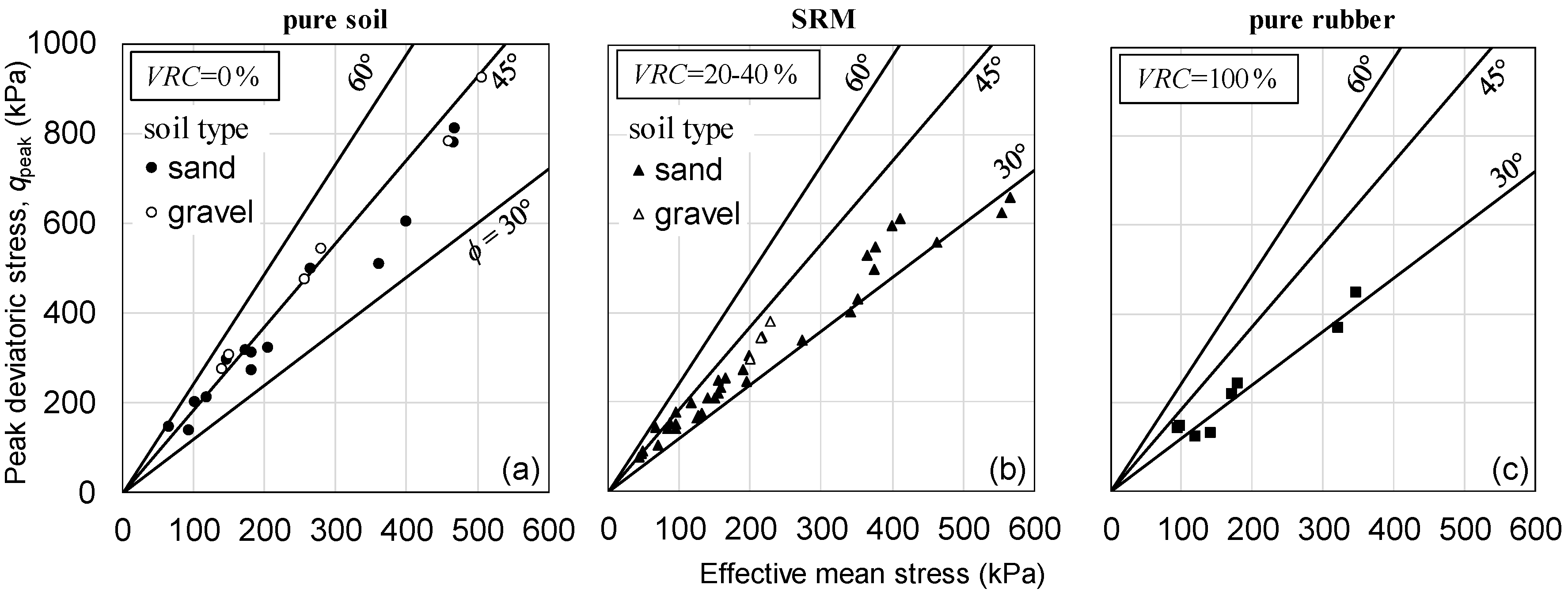

| Material | Car Tire (%) [4] | Truck Tire (%) [4] | Car Tire (%) [5] | Truck Tire (%) [5] | |
|---|---|---|---|---|---|
| Rubber | Natural | 19 | 34 | 47 | 45 |
| Synthetic | 24 | 11 | |||
| Fillers (carbon black, silica) | 26 | 24 | 21.5 | 22 | |
| Plasticizer (oil and resin), chemical additives and others | 14 | 10 | 9.5 | 7 | |
| Reinforcement | Steel | 12 | 25 | 16.5 | 23 |
| Textile | 5 | --- | 5.5 | 3 | |
| VRC (%) | Skeleton Material | Remarks | ||
|---|---|---|---|---|
| D50R << D50S | D50R ≈ D50S | D50R >> D50S | ||
| 0 |  |  |  | Rigid soil skeleton. |
| 20 |  |  |  | Soil-controlled stiffness; rubber may prevent buckling of soil columns; D50R << D50S: segregation if rubber can pass through soil pores. |
| 40 |  |  |  | D50R << D50S: Transaction mixture. Rubber separates soil contacts at low pressures; soil contacts may form at large pressures; D50R >> D50S and D50R ≈ D50S: Rubber forms percolating skeleton. There is soil-soil grain interaction. |
| 60 |  |  |  | D50R << D50S and D50R ≈ D50S: Soil forms percolating skeleton. There is rubber-rubber particle interaction; D50R >> D50S: Soil separates rubber contacts. |
| 80 |  |  |  | Rubber-controlled stiffness; D50R >> D50S: Segregation if soil can pass through rubber pores. |
| 100 |  |  |  | Soft rubber skeleton. |
Publisher’s Note: MDPI stays neutral with regard to jurisdictional claims in published maps and institutional affiliations. |
© 2021 by the authors. Licensee MDPI, Basel, Switzerland. This article is an open access article distributed under the terms and conditions of the Creative Commons Attribution (CC BY) license (https://creativecommons.org/licenses/by/4.0/).
Share and Cite
Tasalloti, A.; Chiaro, G.; Murali, A.; Banasiak, L. Physical and Mechanical Properties of Granulated Rubber Mixed with Granular Soils—A Literature Review. Sustainability 2021, 13, 4309. https://doi.org/10.3390/su13084309
Tasalloti A, Chiaro G, Murali A, Banasiak L. Physical and Mechanical Properties of Granulated Rubber Mixed with Granular Soils—A Literature Review. Sustainability. 2021; 13(8):4309. https://doi.org/10.3390/su13084309
Chicago/Turabian StyleTasalloti, Ali, Gabriele Chiaro, Arjun Murali, and Laura Banasiak. 2021. "Physical and Mechanical Properties of Granulated Rubber Mixed with Granular Soils—A Literature Review" Sustainability 13, no. 8: 4309. https://doi.org/10.3390/su13084309
APA StyleTasalloti, A., Chiaro, G., Murali, A., & Banasiak, L. (2021). Physical and Mechanical Properties of Granulated Rubber Mixed with Granular Soils—A Literature Review. Sustainability, 13(8), 4309. https://doi.org/10.3390/su13084309







